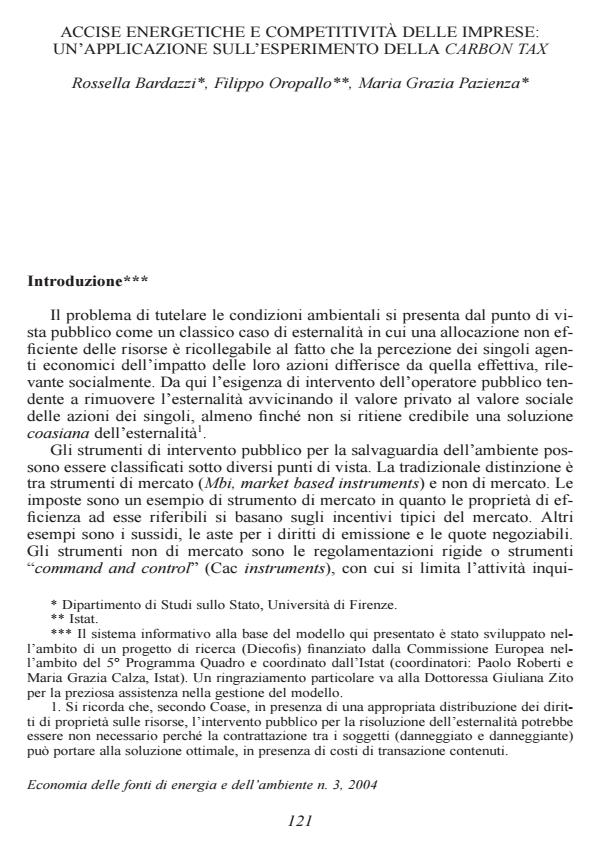Accise energetiche e competitività delle imprese: un'applicazione sull'esperimento della carbon tax
Journal title ECONOMIA DELLE FONTI DI ENERGIA E DELL’AMBIENTE
Author/s Rossella Bardazzi, Filippo Oropallo, Maria Grazia Pazienza
Publishing Year 2006 Issue 2004/3
Language Italian Pages 44 P. File size 343 KB
DOI
DOI is like a bar code for intellectual property: to have more infomation
click here
Below, you can see the article first page
If you want to buy this article in PDF format, you can do it, following the instructions to buy download credits

FrancoAngeli is member of Publishers International Linking Association, Inc (PILA), a not-for-profit association which run the CrossRef service enabling links to and from online scholarly content.
An international debate on which economic instrument should be used to reduce pollutant emissions has begun since the nineties when the awareness of climatic risks aroused and first attempts to introduce a European carbon tax were made. Although this project failed, several national programmes of carbon/energy taxes have been developed with a common concern for industrial competitiveness of energy and/or carbon-intensive firms. Therefore, double dividend schemes have been applied to reduce existing distorsive taxes while introducing a higher burden on energy products. This paper reviews the most important European case studies and analyses the effects of the introduction of a carbon tax in Italy on energy expenditure and economic profitability of Italian manufacturing enterprises. This tax has been introduced in 1998 and should have progressively increased up to the final tax rates in 2005. However, this process halted in the year 2000 as the world energy prices increased and the ultimate rates have never been applied. Nonetheless, our analysis offers relevant insights both because energy excises are a major instrument in environmental policy and because industrial activities affected by energy taxes will also be affected by the tradable permits scheme recently adopted by the European Union. The study is performed with a microsimulation model to simulate changes in energy excises and the associated reduction of social contributions to achieve the double dividend. Existing empirical analyses have usually been carried out at aggregate or sectoral level, but the effects on costs both of carbon tax and of compensative measures differ at the firm level, thus it is significant to study the impact on economic profitability on individual units of analysis. The data show that energy expenditure as a component of intermediate costs varies by economic activity as well as the energy mix used in the production process, thus suggesting possible competitiveness problems for some firms as taxation is linked to the carbon content of each energy source. A further element is the sectoral and dimensional variability of prices of some energy products which introduces an additional information to evaluate the impact of rising international energy quotations. The empirical results show a large sectoral and dimensional differentiation of economic effects although the estimated impact on competitiveness is negligible for most sectors. The difference is due to the energy intensity of production and to the energy mix for each process as well as to the quantity of labour employed. In general, the tax burden in the year 2000 has produced fiscal savings compared to the previous tax rules, as the reduction of social contributions has been higher than the cost due to the carbon tax. However, some exceptions occur: economic activities where heavily-taxed products are used such as coal and coke are not fully compensated by the social contribution cut: this is the case of metal products and the production of non metallic mineral products. Moreover, small and medium enterprises benefited more than large industrial firms. As the EU tradable permits scheme will fully come into force and a policy mix of excises and permits on energy products will deploy its effects on the same group of energy-intensive firms, this set of fiscal environmental rules is likely to produce dissimilar effects by economic sectors and by firm size which are worth investigating.
Rossella Bardazzi, Filippo Oropallo, Maria Grazia Pazienza, Accise energetiche e competitività delle imprese: un'applicazione sull'esperimento della carbon tax in "ECONOMIA DELLE FONTI DI ENERGIA E DELL’AMBIENTE" 3/2004, pp , DOI: